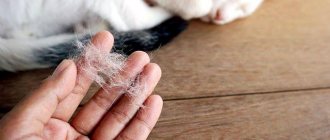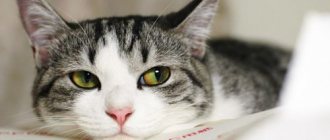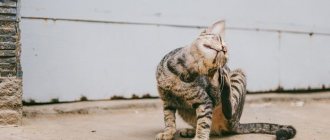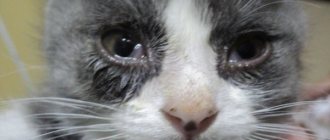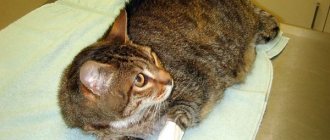Seasonal shedding in cats occurs twice a year and normally lasts for 2-3 weeks. But if the hair loss is pathological, then large bald patches appear on the pet’s body. The causes of abnormal molting may be physiological changes in the body, the presence of skin diseases or severe internal pathologies.
Let's find out why a cat goes bald and whether it is possible to help your pet at home.
Hair loss in cats
Shedding is a normal physiological process that accompanies a cat throughout its life. According to the laws of nature, cats should change their coat twice a year:
- when daylight hours decrease or it gets colder outside, the animal’s body activates protective reactions that are aimed at preserving heat and the cat actively grows hair, getting rid of low-quality hair;
- when it gets warmer outside, the cat “undresses” - sheds its undercoat to avoid overheating.
Pets who live in an apartment are constantly warm and their body is forced to adapt to the surrounding air temperature. With the onset of cold weather outside, domestic cats intuitively grow overgrown, then the heating in the houses turns on and the animals become hot, as a result of which they are forced to shed prematurely. It is this kind of hair loss that drags on and turns into spring molting, and therefore many owners consider the process permanent. This is also a kind of norm.
However, if a cat has visible bald spots on its neck or back for no reason, hair falls out in clumps, itching and sores arise from scratching, you need to show the animal to a veterinarian.
Is it normal for cats to eat their own hair?
It is normal for cats to eat their fur, especially when grooming themselves.
Because cats groom themselves with their tongues, they are accustomed to eating at least a little of their fur every day. You probably only worry about your cat eating fur when you see a large piece of fur hanging from his lip. Otherwise, do you think twice about the fact that your cat is eating its own fur while licking itself? Probably no.
Some cats are also very clean. If your cat pulls pieces of fur from her body, she may eat them even after she spits them out. This may seem like a strange habit, and it probably is, but cats do it anyway.
© shutterstock
Types of alopecia
In veterinary medicine and medicine, the term “alopecia” is used, which means pathological thinning or complete loss of hair in a certain area of a cat’s body.
There are 2 forms of the disease, which can be classified according to the location of the bald patches:
- Diffuse or generalized alopecia is profuse hair loss throughout the body, which leads to significant thinning of the hairline.
- Zonal (focal) alopecia - when hair comes out on a certain area of the body (head, paw, neck, tail).
Alopecia can also be:
- self-induced (self-induced);
- spontaneous (against the background of calcium, zinc and iron deficiency in the cat’s body);
- parasitic (fleas, subcutaneous mites);
- genetic;
- post-traumatic, postoperative.
Self-induced (self-induced)
This type of alopecia is quite common among decorative cat breeds living in apartments. Out of boredom, stress, or for other reasons, the cat begins to lick itself frequently, stopping at certain areas of the body. As a result, the fur becomes thinner and falls out, and constant exposure to the cat's rough tongue prevents the growth of new undercoat. From the outside it looks like a hairless pink spot without injuries or sores. It takes a long time to deal with the problem.
The best and proven methods:
- Purchase a cat diffuser or spray to diffuse pheromones or essential oils. For example, Feliway (pheromones stabilize the cat’s emotional background and reduce unusual forms of stressful behavior) or Relaxivet (lavender, rosemary and geranium oils relieve nervous tension and anxiety).
- Eliminate the cause of stress (get a second cat, fish, buy new toys, a scratching post house, build loopholes or tunnels for exciting leisure time for kittens in the absence of their owners). This will distract your pet from its excessive hygiene.
Sometimes a cat independently licks one area of the body where it feels pain, itching, or burning. This usually occurs after injections into the withers, vaccinations, when applying bandages or the formation of a tumor.
If the cause of anxiety is eliminated, the animal will calm down. You can resort to using a protective collar, which is sold at a pet store.
Independent (spontaneous)
This type of baldness in cats is the most unpredictable and mysterious, because it appears spontaneously and for no particular reason. The fur falls out and does not grow back. Diagnosis is carried out with the participation of a veterinarian in the clinic, who will clarify the following information from the animal owner:
- What is the diet and have there been any changes in the cat’s diet recently? A sudden change in food can cause thinning of the coat (especially if there is food intolerance or the new food is of poorer quality).
- What medications does your pet take and what is it being treated for? Taking some medications can cause your cat's fur to fall out in clumps. Once treatment is complete, the hair will grow back.
- Have you had contact with other animals? This may be the cause of the development of parasitic diseases on the skin.
- What operations did the cat undergo? There may be no fur at the suture site for a long time.
- Whether there were matings, births (lactation period and kittens) and when.
- Did the cat fall from a height or receive other injuries (strong impacts provoke irreversible processes on the skin).
Important! Only after a complete history has been collected and a series of laboratory tests have been carried out, will the veterinarian be able to determine the cause of the disease and diagnose the cat.
Hypotrichosis
This is a hereditary pathology of kittens, which looks like a hair anomaly - loss of hair (complete or partial), and then growth of it again. Kittens may be born without hair, whiskers, claws, or tongue papillae.
Adult cats often have a complete absence of hair in some areas of the body or the appearance of fluff. A detailed examination of bald spots can reveal altered hair follicles or their complete absence.
Hypotrichosis is not a disease, but a genetic disorder that cannot be treated. It is recommended to castrate animals with this developmental feature.
Breeds prone to this pathology in genotype:
- Burmese (or sacred Burma);
- Burmese (or Burmese);
- Devon Rex;
- Siamese
Why do cats bite their own paws?
Cats bite their own feet when grooming themselves. Treatment includes many areas, not only the shoulders, but sometimes the leg and foot area. No matter where your cat can reach, she will try to groom it. Feet especially need careful care because your cats use them frequently.
Sometimes a cat will bite your legs if there are fleas crawling around or if they are dirty. Otherwise this is completely normal behavior that is to be expected.
Dermatophytosis (lichen)
Dermatophytosis is a disease of fungal origin, its characteristic symptoms are:
- the cat's hair falls out in clumps on one area of fur;
- the edges of the hairless area have smooth outlines (as they were cut);
- periodically itching appears in the place where the hair has fallen out and subsequently sores form (if the cat licks the affected area);
- Without treatment, the hair continues to fall out in clumps as the bald area increases in size.
Diagnostics
Ringworm is determined in three ways:
- Under a Voodoo lamp, where the affected areas of the body will glow.
- Examination of affected hairs under a microscope.
- Sowing skin flakes from bald patches onto a nutrient medium, which will most accurately determine the type of fungus.
Treatment for excessive hair loss in cats
Treatment of trichophytosis consists of the following stages:
- Local application of antifungal ointment or spray (for example, Fungin or Clotrimazole ointment) if the lesion is small or isolated.
- Bathing the cat in antifungal shampoos and products (Ketoconazole, Imaverol) if large areas are affected.
- The use of tablets with antifungal action, if previous methods do not help.
- Vaccination against lichen in cats that are in contact with a sick animal.
- Using feed with vitamin supplements to improve wool quality.
Skin parasites in cats
Very often, the causes of significant thinning of the coat in cats are skin parasites, namely fleas, lice mites and scabies mites, which cause a number of diseases:
- Demodicosis, notoedrosis - infection with scabies mites that live under the skin or in hair follicles. In sick cats, hair comes out all over the body in clumps, sores, scabs and wounds form from scratching with claws.
- Otodectosis is ear scabies, in which the affected area is concentrated in the area of the outer and inner ear. The cause of the disease is microscopic mites. With this disease, hair grows in the cat's ear area.
- Cheyletiellosis or wandering dandruff in cats is characterized by intense hair loss on the sides of the body. However, the most pronounced symptom is transient white or black dandruff. The cause of the disease is microscopic mites that live in desquamated particles of the epidermis (dandruff)
- Flea infestation (flea infestation) entails constant itching, sores, hair loss in clumps in areas of intense scratching and severe anxiety of the animal.
Diagnosis and treatment
The best diagnostic methods for shedding cats are:
- superficial or deep scraping from the affected area of the body to determine the type of tick under a microscope;
- Scotch tape test is a home option for determining skin parasites (in veterinary medicine it is also used in laboratories as an express method);
- The method of combing a cat on white paper allows you to find feces and flea larvae in the fur (relevant for black and dark colors).
Treatment is aimed at the use of specific veterinary drugs:
- for scabies (demodex, notoedrosis, cheyletieliosis) - drops on the withers Stronghold, Lawyer, Inspector;
- against fleas and lice eaters - any insectoacaricides for cats (drops, shampoos, sprays).
- for otodectosis - drops in the ear with anti-mite action (Amit, Amirazin, Otoferonol, Bars).
Why does a cat bite itself when grooming?
You've seen how your cat spends most of the day grooming every inch of her body. Cats are obsessed with cleanliness for many reasons. The instinctive reason why domestic cats pass from feral cats is to keep their scent away from predators. Your kitty's rough, sandpaper-like tongue allows him to groom his fur and get rid of unwanted odors and dirt.
© shutterstock
Sometimes something can get stuck in your cat's fur, especially if it's an outdoor cat. They may also have a tangle or knot that is particularly bothering them. These are typical reasons why you will see your cat biting while grooming. Cats may also bite their paws and nails, usually to remove debris or other dirt that is stuck there.
If that's all your cat does, there's no reason to worry. However, sometimes your cat's bite can be a sign of something more serious.
Allergy
Cat allergies are a common problem in veterinary dermatology. Recently, it has been increasingly diagnosed with increased skin sensitivity, when cats have a lot of hair coming out. The most common types of allergies include:
- Food intolerance to animal protein or a specific product (can be expressed in the form of periodic itching, scratching, loss of tufts of hair in different parts of the body and deterioration in the quality of the coat, tearing).
- Flea allergic dermatitis is a negative reaction to flea saliva in cats. It looks like severe itching, restlessness of the animal and significant uneven hair loss of the pet as a result of independent frequent licking.
- Intolerance to medications or a side effect from therapy for a chronic disease (oncology or hormonal imbalance).
In each specific case, treatment is selected individually. If you are allergic to food, the veterinarian prescribes a diet or develops a therapeutic diet. If there is a reaction to fleas, it is necessary to take all measures to eliminate them (treating not only the animal, but also the premises with special preparations all year round). And if your cat itches and goes bald due to medications, you will need to consult a veterinarian.
Attention! You should not try to independently treat allergic reactions in cats and give them human medications, such as Suprastin, Tavegil and analogues. Due to the side effects of medications and incorrectly calculated dosage “by eye,” the animal can be poisoned.
How to treat?
Constant licking of fur down to the epidermis is not normal and requires therapeutic measures. It is impossible to eliminate the problem without finding out its original source. To do this, contact a veterinarian who will conduct a diagnosis and select medications if necessary. Drug treatment is required for atopic dermatitis. To eliminate itching, the following medications are prescribed for cats:
- "Prednisolone";
- "Dexamethasone."
When a pet licks its fur to the skin under the influence of stress factors, the cat needs to be provided with peace and surrounded with care. If pathological licking occurs against the background of an allergic reaction, then the influence of the irritant on the cat’s body is immediately excluded. If the violation does not go away, then additional antihistamines are prescribed. To combat the problem caused by small parasites, pet hair is treated. For this purpose, you can use antiparasitic drops, tablets or sprays.
Endocrine alopecia in cats
These in cats include hypothyroidism, a disease of the thyroid gland in which the level of production of the hormones T3 and T4 drops sharply. The main symptoms of the disease in a kitten: developmental delay, lethargy, disproportionate body formation, underdeveloped teeth, later completion of bone formation.
The disease is expressed very characteristically on the coat: in kittens, the body is covered mainly with undercoat with a small amount of outer hair, the fur constantly mats, and may contain dandruff. When cutting, hairs are easily pulled out and grow slowly.
Treatment for this disease depends on the underlying cause of hypothyroidism. If the disease is acquired after treating your pet with radioactive iodine or as a result of surgery, you will have to wait until the body recovers on its own.
If the cat's thyroid gland is irreversibly damaged, then replacement therapy is required, namely hormones in the form of tablets for lifelong use. With this treatment, the cat’s body will recover after a few months. In such a situation, the owner must remember to feed the cat hormonal drugs daily.
Alopecia associated with cat breed
Today, hairless cats and half-naked breeds are very popular. These include:
- sphinxes;
- rexes;
- Devon Rex;
- lykoy.
However, when breeding these cats, the following problems arise:
- In sphinxes, individual hairs can appear in the form of twisted thin rods; it is difficult for them to break through the thickness of the skin. As a result, nodules develop that turn into comedones.
- In semi-hairless breeds, the coat may grow and shed unevenly, which is considered normal.
- Likoy cats have no hair on their faces in places - this is a breed standard that must be taken into account.
- In blue and beige rexes, hypotrichosis may occur at a young age due to pigmentation problems (breeding defects).
- The birth of hairless kittens in woolly cat breeds as a result of a spontaneous mutation.
Why does a cat overgroom itself?
Our kittens have complex brains and are very susceptible to psychological complications. Excessive grooming or biting may be a sign that they have mental issues that need to be addressed, most often related to anxiety.
Your cat may have difficulty adjusting to a new routine, a new family member, or other changes in the household. Just as humans may bite their nails or exhibit other physical signs of anxiety, cats often bite their fur. Kitties are creatures of routine. If you notice that they are over-grooming, something is probably bothering them.
Your cat may be over-grooming for medical reasons. Some of them include:
- Allergies : Seasonal or atmospheric allergies can cause skin irritation in your cat. This will cause them to itch and they will bite themselves to make it stop.
- Dry Skin : Just like humans, cats can get dry skin from dry or cold air. They may lick or bite excessively all over the body or one area that particularly bothers them.
- Parasites : Your cat's fur could be home to fleas or other parasites, and you can bet your kitty will chase them down with her teeth to try and get rid of them.
- Pain : A cat may experience pain due to injury or disorder. Their instinct will be to lick the area that hurts them.
© shutterstock
Other causes of hair loss in cats
Uncommon alopecias include:
- Preauricular bald patches are a triangular area with sparse hair above the eyes. Considered normal for most cats.
- Balding of the ears in older cats is a process associated with the aging of animals and is also considered normal. Bald patches should not itch.
- Reversible hair loss under mats, which occurs due to strong tension of the hairs and poor circulation in this area. To avoid such manifestations, you need to do high-quality grooming for the cat yourself or in the salon, and also purchase special haircutters.
Alopecia is always an unpleasant symptom for the owner of a cat of any breed. Therefore, the problem requires special attention and a visit to the veterinarian in order to recognize the disease at an early stage and preserve the true beauty of the furry pet.
